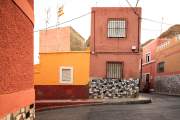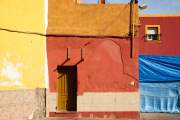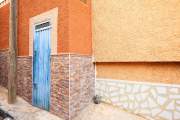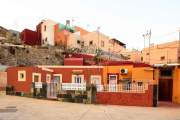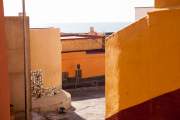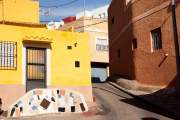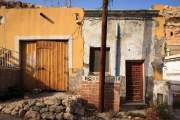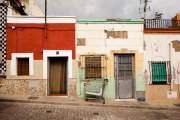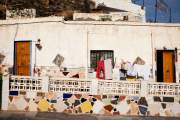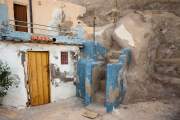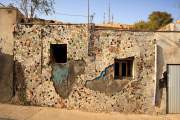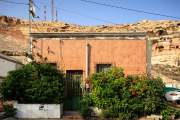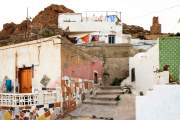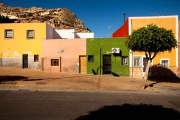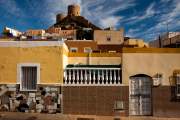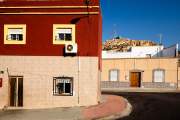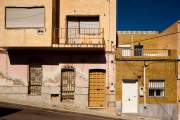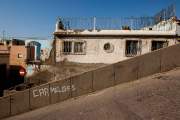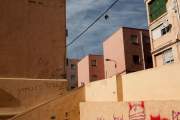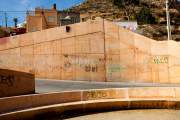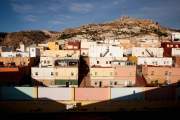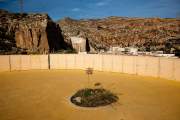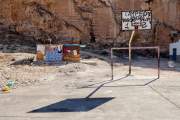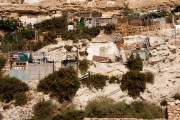GalleryLa Chanca
“The perspective of Almeria, viewed from the heights of the Alcazaba, is one of the most beautiful in the world.”
Almeria’s Alcazaba, a Moorish castle perched above the city, overlooks the neighborhood of La Chanca. It is a historically impoverished zone made up of small dwellings built into the hillside on the outskirts of the city. The inhabitants painted their homes using whatever ingredients were available, resulting in a multicolored patchwork. Ruins still remain of a nineteenth century lead mining and transport operation that ran down the mountain to the nearby port. La Chanca has long been home to a diverse population, including fishermen and their families, a strong community of gypsies, and, more recently, immigrants from Morocco.
Juan Goytisolo, Spain’s most influential literary exile, described the view down from the Alcazaba in 1962:
“The district of La Chanca crouches at your feet, luminous and white, like an invention of the senses. In the depths of the valley, the modest houses appear like a game of dice, thrown there capriciously. The geological violence, the nakedness of the landscape is frightening. Tiny, rectangular, the huts climb the slope and set themselves in the broken geography of the mountain, carved like carbuncles. Around La Chanca, the yellow rock extends itself the same as an ocean, the rugged undulations of the moorland cut off in the ridges of the Sierra de Gádor. The overlook takes in an expansive panorama and the observer feels a little like the Diablo Cojuelo.* The inhabitants of the suburb carry on with their wretched lives without worrying that they are being watched from above. From time to time, a guide ponders the marvels of the place and the tourists poke out of the battlements and bombard it with their cameras.”
[*The mischievous “Crippled Devil” who, in a popular version of the story, reveals the tricks and misfortunes that occur inside the walls of the apartments of Madrid.]
La Chanca has a complex history with photographers and photography. Goytisolo’s book did not include any photographs. In fact, a family he visits tells him about a French couple who had recently shown up with a “portrait machine.” The grandmother wanted her grandchildren to wash and dress up for the photograph, but the tourists told them not to, preferring to photograph them in their disheveled state. They took over 100 photographs. The grandmother later confesses to Goytisolo that she didn’t understand their true intentions at the time. “Sometimes one does things without understanding,” she says, “I think if they came now I would curse them.”
Carlos Perez Siquier began photographing the streets and people of La Chanca in 1957. He visited the neighborhood on weekends while free from his day job at a local bank. With limited funds, he sometimes used discarded pieces of unexposed film from movie productions in Almeria. Perez Siquier explained in an interview years later that his intent was not to denounce the conditions of La Chanca or conduct a sociological study, but simply to show the people as they are and reveal their dignity among difficult circumstances.
“My attention is directed to daily life, in all its visible manifestations. It is not the strange or unusual that most attracts my eye, as its value depends largely on the unexpected. It is the simple and everyday, the authentic in its vulgarity, that I want to highlight intensely.”
Perez Siquier continued to return to La Chanca over the years. His early photographs, in black and white, are scenes from neighborhood life lived largely in the streets. Children playing, a laughing wedding party, a couple carrying an oversized wardrobe, or a crowd gathered around a tightrope walker. A few of the frames focus on stark abstract shapes, patterns created by hanging clothes and shadows on the ground, a black umbrella hanging upside down against a white wall, or a series of white chimneys rising out of the eroded rock wall. He later began using color film, showcasing the varied palette of the painted houses. In one series of images, he hones in on multicolored layers of peeling paint emerging from walls and doors.
Perez Siquier’s early images were part of a new photography movement emerging in Spain during the 1950s and 60s. The new photography rejected the officially sanctioned images which romanticized the Spanish landscape and traditional village life. Instead, they favored realism and focused on marginalized communities and the urban periphery. Along with Madrid and Barcelona, Almeria became a locus for the photographic vanguard. Perez Siquier’s images of La Chanca first appeared in Afal, an influential photography magazine published out of Almeria.
Goytisolo’s book was published covertly in Paris and for years was not openly available in Spain. When a Spanish edition finally emerged in 1981, under a newly-democratic government, one of Perez Siquier’s images appeared on the cover.
In recent years, La Chanca has been gaining international attention for its unique model of social organization and integration. City services do not extend up the steep, winding streets along the hillside, so residents have developed cooperatives to clean and maintain public spaces. The public school includes classes in Arabic language and culture, and students learn about the diverse history of the region through musical performances and festivals. At the same time, however, the neighborhood remains isolated from the rest of the city. A local organization is working to gain UNESCO recognition for La Chanca as a cultural World Heritage site.
Local singer/songwriter Sensi Falan includes more outstanding views of La Chanca in her recent music video:
